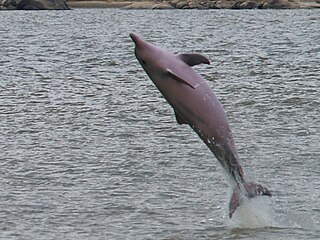| Tijamuchi River | |
|---|---|
 | |
| Location | |
| Country | Bolivia |

The Tijamuchi River is a river of Bolivia, located in the Beni department. It is known for its significant river dolphin (Inia geoffrensis) population. [1] [2]
| Tijamuchi River | |
|---|---|
 | |
| Location | |
| Country | Bolivia |

The Tijamuchi River is a river of Bolivia, located in the Beni department. It is known for its significant river dolphin (Inia geoffrensis) population. [1] [2]

The Amazon river dolphin, also known as the boto, bufeo or pink river dolphin, is a species of toothed whale endemic to South America and is classified in the family Iniidae. Three subspecies are currently recognized: I. g. geoffrensis, I. g. boliviensis and I. g. humboldtiana. The position of the Araguaian river dolphin within the clade is still unclear. The three subspecies are distributed in the Amazon basin, the upper Madeira River in Bolivia, and the Orinoco basin, respectively.

River dolphins are a polyphyletic group of fully aquatic mammals that reside exclusively in freshwater or brackish water. They are an informal grouping of dolphins, which itself is a paraphyletic group within the infraorder Cetacea. Extant river dolphins are placed in two superfamilies, Platanistoidea and Inioidea. They comprise the families Platanistidae, the possibly extinct Lipotidae, Iniidae and Pontoporiidae. There are five extant species of river dolphins. River dolphins, alongside other cetaceans, belong to the clade Artiodactyla, with even-toed ungulates, and their closest living relatives the hippopotamuses, from which they diverged about 40 million years ago. Specific types of dolphins can be pink.

Iniidae is a family of river dolphins containing one living genus, Inia, and four extinct genera. The extant genus inhabits the river basins of South America, but the family formerly had a wider presence across the Atlantic Ocean.

The tucuxi, alternatively known in Peru bufeo gris or bufeo negro, is a species of freshwater dolphin found in the rivers of the Amazon basin. The word tucuxi is derived from the Tupi language word tuchuchi-ana, and has now been adopted as the species' common name. Despite being found in geographic locations similar to those of 'true' river dolphins such as the boto, the tucuxi is not closely related to them genetically. Instead, it is classed in the oceanic dolphin family (Delphinidae).

Inia is a genus of river dolphins from South America, containing one to four species.

Trinidad, officially La Santísima Trinidad, is a city in Bolivia, capital of the department of Beni. The population is 130,000. While historically a peripheral city in Bolivia, Trinidad is today an important center for the Bolivian Bovine industry and has enjoyed a modest economic boom in recent years and has an HDI index of above 0.700.
Güeppi-Sekime National Park is a protected area located in the Peruvian region of Loreto, on the border with Ecuador. The park encompasses 203,628.51 hectares (2,036 km2) of forests in a landscape that features hills and seasonally flooded lowlands.
Pink dolphin may refer to:

Anavilhanas National Park is a national park that encompasses a huge river archipelago in the Rio Negro in the state of Amazonas, Brazil. It is part of a World Heritage Site.

Capitán Av. Selin Zeitun Lopez Airport is an airport serving Riberalta, a port city on the Beni River in the Beni Department of Bolivia. The airport is in the western section of the city, near the confluence of the Beni and Madre de Dios Rivers.

Boto is a Portuguese name given to several types of dolphins and river dolphins native to the Amazon and the Orinoco River tributaries. A few botos exist exclusively in fresh water, and these are often considered primitive dolphins.

The Bolivian river dolphin is a species of the genus Inia.

Eunectes beniensis is a boa species known only from the northeastern parts of Bolivia. Its common names, the Bolivian anaconda and Beni anaconda, are derived from the geographic location of its native habitat: the Beni area of Bolivia. Like all boas, it is nonvenomous.

The Araguaian river dolphin or Araguaian boto is a South American river dolphin population native to the Araguaia–Tocantins basin of Brazil.
The Serra de Santa Bárbara State Park is a state park in the state of Mato Grosso, Brazil. It preserves a unique environment where the Amazon rainforest, pantanal and cerrado meet, and holds many endemic or endangered species.
Piagaçu-Purus Sustainable Development Reserve is a sustainable development reserve in the state of Amazonas, Brazil.

The Aguaro-Guariquito National Park, also rendered as Aguaro Guariquito National Park, is a protected area with the status of national park in the South American country of Venezuela. Located in the region of the Llanos, it extends over the municipalities of Francisco de Miranda and Jose Rondon in Guárico state.

The Madeira–Tapajós moist forests (NT0135) is an ecoregion in the Amazon basin. It is part of the Amazon biome. The ecoregion extends southwest from the Amazon River between its large Madeira and Tapajós tributaries, and crosses the border into Bolivia. In the south it transitions into the cerrado biome of Mato Grosso. In the state of Rondônia it contains some of the most degraded land of the Amazon basin.

The Iquitos várzea (NT0128) is an ecoregion of flooded forest along rivers in Brazil, Peru and Bolivia in the west of the Amazon biome. The forest is seasonally flooded up to 7 metres (23 ft) by whitewater rivers carrying nutrient-rich sediment from the Andes. The meandering rivers often shift course, creating a complex landscape of oxbow lakes, marshes, levees and bars, with grasslands, shrubs and forests in different stages of succession. During the extended flood periods fish enter the forest in search of fruit. The várzea is accessible by the navigable rivers that run through it, and has suffered from extensive deforestation to extract timber and create pasture for livestock.